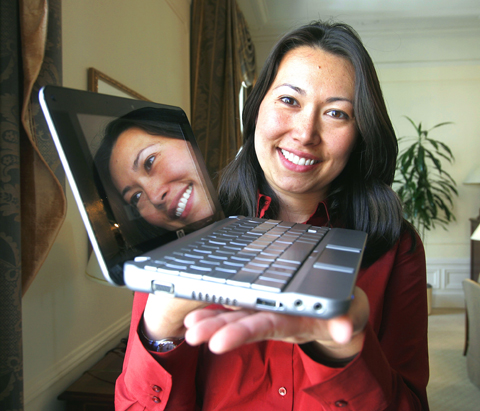One more of the world’s biggest technology companies is clamoring to enter the growing market for pint-sized computers targeted mainly for pint-sized customers.
Hewlett-Packard Co, the No. 1 seller of personal computers worldwide, said yesterday it’s throwing its weight behind a new class of miniaturized laptops, a fledgling market already populated with products from Intel Corp, the world’s largest semiconductor company, and Asustek Computer Inc (華碩電腦), the world’s largest maker of computer motherboards.
The machines are so new the industry has not settled on a name for low-cost and scaled-down laptops used primarily for surfing the Internet and performing other basic functions like word processing.

PHOTO: AP
Intel has labeled them “netbooks,” and it expects more than 50 million netbooks to be in circulation by 2011.
HP executives say their new machines, which go on sale later this month, are an important piece of the Palo Alto-based company’s effort to build market share in schools, where machines had to be smaller and cheaper without losing too many functions.
The companies also expect adults to cotton to the idea of buying two laptops — a lightweight one just for Web browsing on the go and a full-power machine for the home or office.
But industry executives acknowledge that the market is untested and that no one knows what demand will be once the machines are deployed widely.
HP’s foray comes in the form of a new computer called a “Mini-Note” that weighs less than 1.4kg with a screen that measures 22.6cm diagonally. The machines start at under US$500 for a Linux-based model. Prices go up for Windows Vista models with faster processors.
The processors HP is using are made by VIA Technologies Inc (威盛電子), the distant third-ranked player in the microprocessor space, and come in clock speeds up to 1.6 gigahertz. The inclusion is a big win for VIA, which trails Intel and Advanced Micro Devices Inc by a wide margin in the microprocessor market.
HP executives say the only major feature its Mini-Note lacks is an optical drive for ingesting DVDs and CD-ROMs, which can be bought separately. But they say many schools requested the drives be left out to prevent students from playing unauthorized games.
The Mini-Note will compete primarily with Intel’s Classmate PCs — which are designed by Intel and feature Intel chips but are built and branded by other companies — and Asustek’s Eee PC.
To a lesser extent, they also will go up against the XO laptop from the Cambridge, Massachusetts, nonprofit One Laptop per Child (OLPC), which is intended mainly for schoolchildren in developing countries.
Intel says it has sold “tens of thousands” of Classmate PCs since they went on sale last year. And OLPC says it has sold hundreds of thousands of the XO. Figures were not immediately available for sales of the Eee.

WEAKER ACTIVITY: The sharpest deterioration was seen in the electronics and optical components sector, with the production index falling 13.2 points to 44.5 Taiwan’s manufacturing sector last month contracted for a second consecutive month, with the purchasing managers’ index (PMI) slipping to 48, reflecting ongoing caution over trade uncertainties, the Chung-Hua Institution for Economic Research (CIER, 中華經濟研究院) said yesterday. The decline reflects growing caution among companies amid uncertainty surrounding US tariffs, semiconductor duties and automotive import levies, and it is also likely linked to fading front-loading activity, CIER president Lien Hsien-ming (連賢明) said. “Some clients have started shifting orders to Southeast Asian countries where tariff regimes are already clear,” Lien told a news conference. Firms across the supply chain are also lowering stock levels to mitigate

IN THE AIR: While most companies said they were committed to North American operations, some added that production and costs would depend on the outcome of a US trade probe Leading local contract electronics makers Wistron Corp (緯創), Quanta Computer Inc (廣達), Inventec Corp (英業達) and Compal Electronics Inc (仁寶) are to maintain their North American expansion plans, despite Washington’s 20 percent tariff on Taiwanese goods. Wistron said it has long maintained a presence in the US, while distributing production across Taiwan, North America, Southeast Asia and Europe. The company is in talks with customers to align capacity with their site preferences, a company official told the Taipei Times by telephone on Friday. The company is still in talks with clients over who would bear the tariff costs, with the outcome pending further

Six Taiwanese companies, including contract chipmaker Taiwan Semiconductor Manufacturing Co (TSMC, 台積電), made the 2025 Fortune Global 500 list of the world’s largest firms by revenue. In a report published by New York-based Fortune magazine on Tuesday, Hon Hai Precision Industry Co (鴻海精密), also known as Foxconn Technology Group (富士康科技集團), ranked highest among Taiwanese firms, placing 28th with revenue of US$213.69 billion. Up 60 spots from last year, TSMC rose to No. 126 with US$90.16 billion in revenue, followed by Quanta Computer Inc (廣達) at 348th, Pegatron Corp (和碩) at 461st, CPC Corp, Taiwan (台灣中油) at 494th and Wistron Corp (緯創) at

NEGOTIATIONS: Semiconductors play an outsized role in Taiwan’s industrial and economic development and are a major driver of the Taiwan-US trade imbalance With US President Donald Trump threatening to impose tariffs on semiconductors, Taiwan is expected to face a significant challenge, as information and communications technology (ICT) products account for more than 70 percent of its exports to the US, Chung-Hua Institution for Economic Research (CIER, 中華經濟研究院) president Lien Hsien-ming (連賢明) said on Friday. Compared with other countries, semiconductors play a disproportionately large role in Taiwan’s industrial and economic development, Lien said. As the sixth-largest contributor to the US trade deficit, Taiwan recorded a US$73.9 billion trade surplus with the US last year — up from US$47.8 billion in 2023 — driven by strong